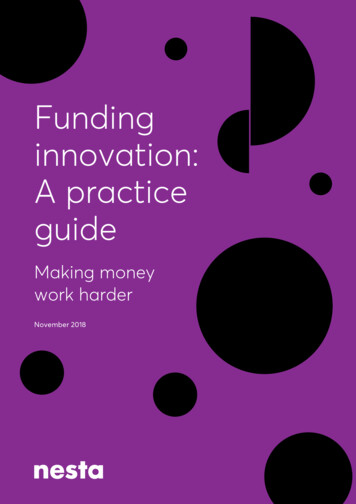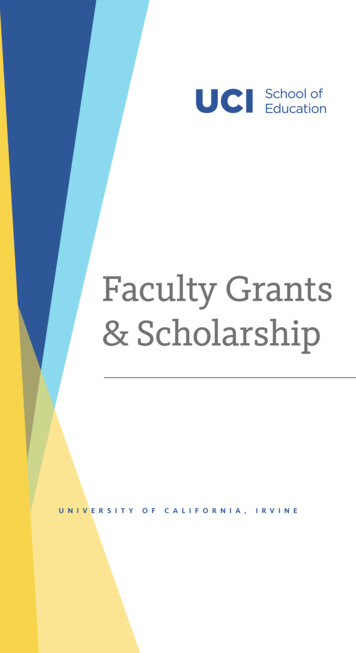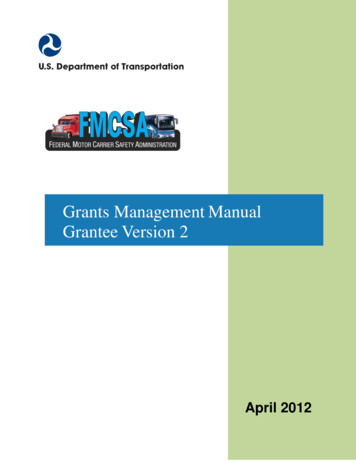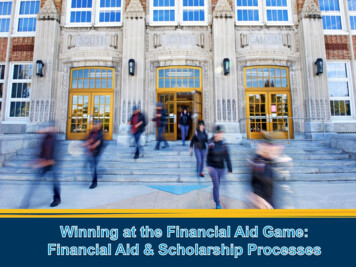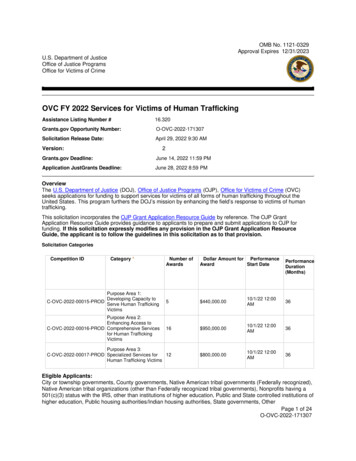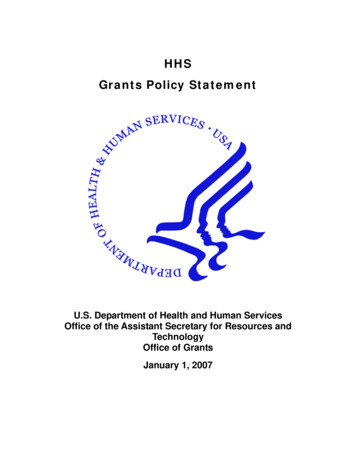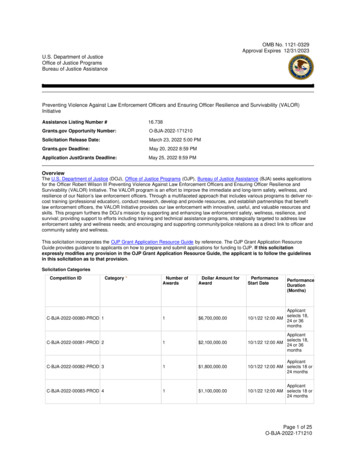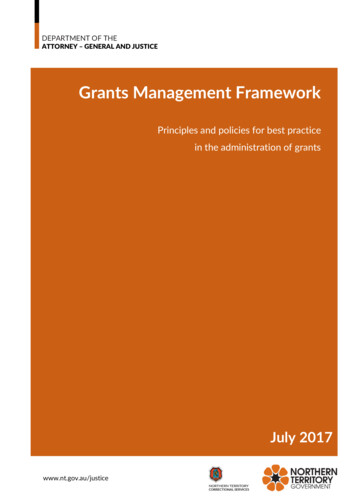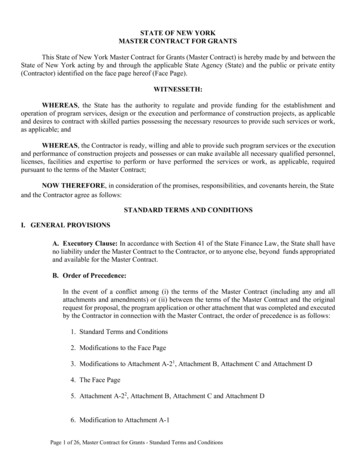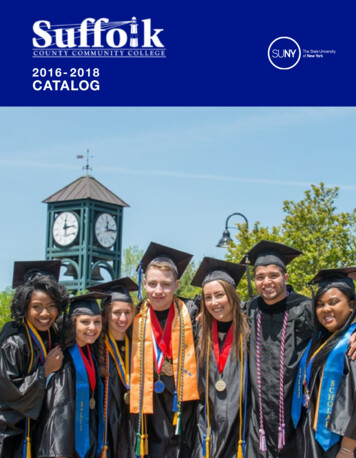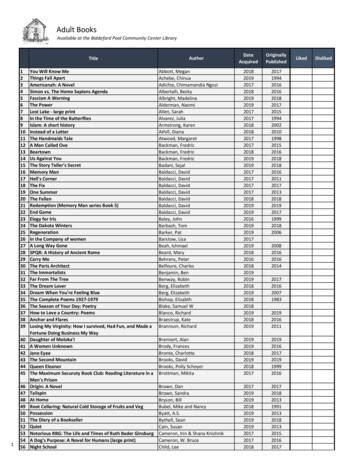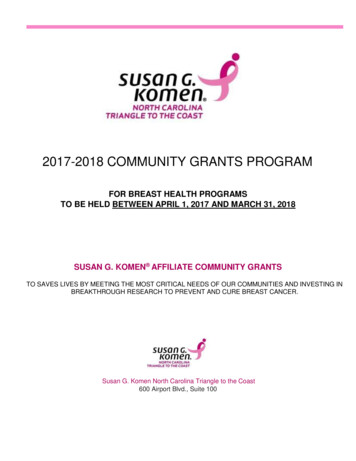
Transcription
2017-2018 COMMUNITY GRANTS PROGRAMFOR BREAST HEALTH PROGRAMSTO BE HELD BETWEEN APRIL 1, 2017 AND MARCH 31, 2018SUSAN G. KOMEN AFFILIATE COMMUNITY GRANTSTO SAVES LIVES BY MEETING THE MOST CRITICAL NEEDS OF OUR COMMUNITIES AND INVESTING INBREAKTHROUGH RESEARCH TO PREVENT AND CURE BREAST CANCER.Susan G. Komen North Carolina Triangle to the Coast600 Airport Blvd., Suite 100
Morrisville, NC 27560www.komennctc.orgTABLE OF CONTENTSContentsKEY DATES . 3ABOUT SUSAN G. KOMEN NORTH CAROLINA TRIANGLE TO THE COAST . 3NOTICE OF FUNDING OPPORTUNITY AND STATEMENT OF NEED . 3ELIGIBILITY REQUIREMENTS . 6ALLOWABLE EXPENSES . 7IMPORTANT GRANTING POLICIES . 8EDUCATIONAL MATERIALS AND MESSAGES . 9REVIEW PROCESS . 11SUBMISSION REQUIREMENTS . 12APPLICATION INSTRUCTIONS . 12APPENDIX A: WRITING SMART OBJECTIVES . 17Page 2 of 19
KEY DATESGrant Writing Workshops*October 6, 2016 ColumbusRegional Health SystemWhiteville, NCOctober 12, 2016 RTPHeadquarters, RTP, NCOctober 14, VidantEdgecombe Hospital, Tarboro,NCGrant Writing Webinar*October 11, 2016 1:00 PMApplication InitiationDeadlineNovember 28, 2016 by 5:00 PMApplication DeadlineDecember 1, 2016 by 5:00 PMAward NotificationMarch 2017Award PeriodApril 1, 2017 - March 31, 2018*If this is your first time applying for funding from Susan G. Komen NCTC using the KomenGrants e-Management System (GeMS), you are required to attend a grant writing workshop. Ifyou have previously applied using GeMS, you must attend either a workshop or a webinar.Please go to www.komennctc.org for more information on workshop/webinar times and/or toregister.ABOUT SUSAN G. KOMEN NORTH CAROLINA TRIANGLE TO THE COASTSusan G. Komen is the world’s largest breast cancer organization, funding more breast cancerresearch than any other nonprofit while providing real-time help to those facing the disease.Komen was founded by Nancy G. Brinker, who promised her sister, Susan G. Komen, that shewould end the disease that claimed Suzy’s life. Komen North Carolina Triangle to the Coast isworking to better the lives of those facing breast cancer in the local community. Through eventslike the Komen Triangle Race for the Cure and the Wilmington Race for the Cure , KomenNorth Carolina Triangle to the Coast has invested over 14 million in community breast healthprograms in 29 counties in central and eastern North Carolina and has helped contribute to themore than 889 million invested globally in research.NOTICE OF FUNDING OPPORTUNITY AND STATEMENT OF NEEDKomen North Carolina Triangle to the Coast will award community grants to organizations thatwill provide breast health and breast cancer projects that address funding priorities, which wereselected based on data from the 2015 Komen North Carolina Triangle to the Coast CommunityProfile Report. The 2015 Community Profile Report can be found on our website ing-process/.Page 3 of 19
While applications will be accepted for programs providing services within the Affiliate servicearea, priority will be given to applicants that provide services to uninsured, underinsured and/orminority individuals from one or more of the counties listed below. Underinsured is defined ashaving some insurance coverage but not enough, or when one is insured yet unable to affordthe out-of-pocket responsibilities not covered by his or her insurer. Bladen CountyCaswell CountyColumbus CountyEdgecombe CountyHalifax CountyNash CountyNorthampton CountyScotland CountyVance CountyWarren CountyWilson CountyThe funding priority areas are listed below: Evidence-based programs that provide access and reduce barriers to breast cancerscreening services. Example programs include mobile mammography, transportationassistance, expansion of clinical hours, free or low-cost clinical breast exams andscreening mammograms.o If providing clinical services, clinics, hospitals, oncology facilities and healthdepartments we encourage you to document in your application that you offerfree, low-cost or subsidized services for high-need patients. These costs shouldreflect the current Medicaid rate. Evidence-based programs that provide access and reduce barriers to breast cancerdiagnostic and treatment services. Example programs include patient navigation,transportation assistance, financial assistance and free or low cost diagnostic or treatmentservices.o Patient navigation is a process by which an individual, a patient navigator, guidespatients through and around barriers in the continuum of care, to help ensureaccess to timely diagnostic, treatment and survivorship services.o Applications may address any aspect of breast cancer diagnosis or treatment,including but not limited to post-diagnosis support, staging, chemotherapy,radiation therapy, hormone therapy, and other follow-up care in a medical setting.Programs that provide evidence-based culturally appropriate breast cancer education thatfocuses on breast self-awareness and local NC BCCCP screening mammographyservices that lead the participant to action (e.g., discussion with doctor about breastcancer risk, receive a clinical breast exam or screening mammogram). When appropriateprograms should provide cultural, economic and privacy sensitivity training to breasthealth providers who serve target populations. Page 4 of 19
Funding LimitsApplicants may request funding from 10,000 up to 50,000 in funds for one year. Programs that provide education and/or social support including survivorshipprograms and services and angel funds may be funded up to 25,000.Programs that provide direct patient care costs and services such as screening,diagnostics and treatment may be funded up to 50,000.Page 5 of 19
ELIGIBILITY REQUIREMENTSApplicants must conform to the following eligibility criteria to apply. Eligibility requirements for theapplicants must be met at the time of Application submission. Individuals are not eligible to apply. Applications will only be accepted from a non-profitorganization with 501(c)3 status (such as an educational institution, hospital or othermedical facility, or a community organization) or a local/state government located in orproviding services to one or more of the following locations:Bladen, Brunswick, Caswell, Chatham, Columbus, Duplin, Durham, Edgecombe,Franklin, Granville, Halifax, Harnett, Johnston, Lee, Moore, Nash, New Hanover,Northampton, Onslow, Orange, Pender, Person, Pitt, Sampson, Scotland, Vance,Warren, Wake, and Wilson Proposed projects must be specific to breast health and/or breast cancer and address thepriorities identified in the Affiliate’s 2015 Community Profile. If a project includes otherhealth issues along with breast cancer, such as a breast and cervical cancer project,funding may only be requested for the breast cancer portion. All past and current Komen-funded grants or awards to applicant are up-to-date and incompliance with Komen requirements. Applicant has documentation of current tax exempt status under the Internal RevenueService code. If applicant, or any of its key employees, directors, officers or agents is convicted of fraudor a crime involving any other financial or administrative impropriety in the 12 months priorto the submission deadline for the application, then applicant is not eligible to apply for agrant until 12 months after the conviction. After such 12 month period, applicant mustdemonstrate in its application that appropriate remedial measures have been taken toensure that any criminal misconduct does not recur.Page 6 of 19
ALLOWABLE EXPENSESFunds may be used for the following types of expenses provided they are directly attributable tothe project: Salaries and fringe benefits for project staff Consultant fees Clinical services or patient care costs Meeting costs Supplies Reasonable travel costs related to the execution of the program Other direct program expenses Equipment, not to exceed 5,000 total, essential to the breast health‐relatedproject to be conductedFunds may not be used for the following purposes: Research, defined as any project or program with the primary goal ofgathering and analyzing data or information.o Specific examples include, but are not limited to, projects or programs designed to: Understand the biology and/or causes of breast cancer Improve existing or develop new screening or diagnosticmethods Identify approaches to breast cancer prevention or riskreduction Improve existing or develop new treatments for breast canceror to overcome treatment resistance, or to understand post‐treatment effects Investigate or validate methods Education regarding breast self-exams/use of breast models Development of educational materials or resources Education via mass media (e.g. television, radio, newspapers, billboards),health fairs and material distribution. These methods may be used to promoteprojects, but evidence-based methods such as 1-1 and group sessions shouldbe used to educate the community and providers. Construction or renovation of facilities Political campaigns or lobbying General operating funds Debt reduction Fundraising (e.g. endowments, annual campaigns, capital campaigns,employee matching gifts, events) Event sponsorships Projects completed before the date of grant approval Payments/reimbursement made directly to individuals Land acquisition Project-related investments/loans Scholarships Thermography Equipment over 5,000 total Projects or portions of projects not specifically addressing breast cancer
Page 7 of 18IMPORTANT GRANTING POLICIESPlease note these policies before submitting a proposal. These policies are non-negotiable. The project must occur between April 1, 2017 to March 31, 2018.The effective date of the grant agreement is the date on which Komen fully executes thegrant agreement and shall serve as the start date of the grant. No expenses may beaccrued against the grant until the contractual agreement is fully executed. Thecontracting process can take up to six weeks from the date of the award notificationletter.Any unspent funds over 1.00 must be returned to Komen North Carolina Triangle to theCoast Affiliate.Grant payments will be made in installments pending compliance with terms andconditions of grant agreement and receipt of satisfactory progress reports.Grantee will be required to submit a minimum of one semi-annual progress report andone final report that will include, among other things, an accounting of expenditures anda description of project achievements. Additional reports may be requested.At the discretion of Susan G. Komen North Carolina Triangle to the Coast Affiliate, thegrantee may request one no cost extension of no more than six months per grant.Requests must be made by grantee no later than 30 days prior to the end date of theproject.Certain insurance coverage must be demonstrated through a certificate of insurance atthe execution of the grant agreement, if awarded. Grantee is required at minimum tohold:o Commercial general liability insurance with combined limits of not less than 1,000,000 per occurrence and 2,000,000 in the aggregate for bodily injury,including death, and property damage;o Workers’ compensation insurance in the amount required by the law in thestate(s) in which its workers are located and employers liability insurance withlimits of not less than 1,000,000; ando Excess/umbrella insurance with a limit of not less than 5,000,000. o In the eventany transportation services are provided in connection with program, 1,000,000combined single limit of automobile liability coverage will be required.o If any medical services (other than referrals) are provided or facilitated, medicalmalpractice coverage with combined limits of not less than 1,000,000 peroccurrence and 3,000,000 in the aggregate will be required.o Grantees are also required to provide Komen North Carolina Triangle to theCoast with a Certificate of Insurance with Susan G. Komen Breast CancerFoundation, Inc., Susan G. Komen North Carolina Triangle to the Coast, itsofficers, employees and agents named as Additional Insured on the abovepolicies solely with respect to the Project and any additional policies and ridersentered into by Grantee in connection with the Project.
Page 8 of 18EDUCATIONAL MATERIALS AND MESSAGESSusan G. Komen is a source of information about breast health and breast cancer for people allover the world. To reduce confusion and reinforce learning, we only fund projects that useeducational messages and materials that are consistent with Komen messages, including ourbreast self-awareness messages -- know your risk, get screened, know what is normal for youand make healthy lifestyle choices. The consistent and repeated use of the same messagescan reduce confusion, improve retention and lead to the adoption of actions we believe areimportant for quality breast care. Please visit the following webpage before completing yourapplication and be sure that your organization can agree to promote these elfAwareness.html.Breast Self-Exam- must not be taught or endorsedAccording to studies, teaching breast self-exam (BSE) has not been shown to be effective atreducing mortality from breast cancer and therefore Komen will not fund education projectsthat teach or endorse the use of monthly breast self-exams or use breast models. As anevidence-based organization, we do not promote activities that are not supported by scientificevidence or that pose a threat to Komen’s credibility as a reliable source of information on thetopic of breast cancer.Creation and Distribution of Educational Materials and ResourcesKomen Affiliate Grantees are encouraged to use Komen-developed educational resources,including messages, materials, toolkits or online content during their grant period. This is toensure that all breast cancer messaging associated with the Komen name or brand are current,safe, accurate, consistent and based on evidence and to avoid expense associated with theduplication of existing educational resources. Komen Grantees can purchase Komeneducational materials at the Affiliate preferred price. If a grantee intends to use othersupplemental materials, they should be consistent with Komen messages.Komen grantees are eligible to receive preferred pricing for Komen educational materials.Komen materials should be used and displayed whenever possible. To view our educationalmaterials, visit www.shopkomen.com.Use of Komen’s Breast Cancer Education Toolkits for Black and African-American Communitiesand Hispanic/Latino Communities and Other ResourcesKomen has developed Breast Cancer Education Toolkits for Black and African-Americancommunities and Hispanic/Latino communities. They are designed for educators andPage 9
organizations to use to meet the needs of these communities. The Hispanic/Latino Toolkit isavailable in both English and Spanish. To access the Toolkits, please visithttp://komentoolkits.org/. Komen has additional educational resources, including onkomen.org, that may be used in community outreach and education projects. Check withKomen North Carolina Triangle to the Coast for resources that may be used in programming.of 18
REVIEW PROCESSEach grant application will be reviewed by at least three independent reviewers. They willconsider each of the following selection criteria:Impact 20%: Will the project have a substantial positive impact on increasing the percentageof people who enter, stay in, or progress through the continuum of care? Will the project havea substantial impact on the need described in the funding priority selected? Is the impact likelyto be long-term?Statement of Need 20%: Does the project address at least one of the funding priorities statedin the RFA and the Affiliate’s 2015 Community Profile? Does the project provide services toone or more of the target communities described in the Affiliate’s 2015 Community Profile?Project Design 20%: Do the goal and objectives described in the Project Work Plan align withthe project description and activities? Is it clear what, specifically, is being done through thisproject? Is the project designed to meet the needs of specific communities including thecultural and societal beliefs, values, and priorities of each community? Is the project evidencebased? Is the budget appropriate and realistic? Does the budget justification explain in detailthe reasoning and need for the costs associated with the project? If the proposed projectincludes collaboration with other organizations, are the roles of the partners appropriate,relevant and clearly defined? How likely is it that the objectives and activities will be achievedwithin the scopeof the funded project?Organization Capacity 15%: Does the applicant organization, Project Director and his/herteam have the expertise to effectively implement all aspects of the project? Is there evidence ofsuccess in delivering services to the target population? Is the organization fiscally capable ofmanaging the grant project, including having appropriate financial controls in place? Does theapplicant organization have the equipment, resources, tools, space, etc., to implement allaspects of the project? Does the organization or staff have appropriate licenses, certifications,accreditations, etc. to deliver the proposed services? Does the organization have a plan toobtain the resources (financial, personnel, partnerships, etc.) needed to sustain the projectbeyond the grant term (if awarded)? Are collaborations (if proposed) likely to be sustainedbeyond the grant term?Monitoring and Evaluation 15%: Is there a documented plan to measure progress against thestated project goal and objectives, and the resulting outputs and outcomes? Is there sufficientmonitoring and evaluation (M&E) expertise for the project? Are there sufficient resources inplace for M&E efforts?County Tier Designation 10%: What tier designation has been assigned to the county in 2016by the North Carolina Department of Commerce? Counties designated as Tier 1 or Tier 2 willbe given extra points in the review process. County Tiers are calculated using four factors:Page 11 of 19
Average unemployment rateMedian household incomePercentage growth in populationAdjusted property tax base per capitaThe grant application process is competitive, regardless of whether or not an organization hasreceived a grant in the past. Funding in subsequent years is never guaranteed.Applicant Support: Questions should be directed to:Julie McQueen, CHESDirector of Community Healthjmcqueen@komennctc.org919-493-2873SUBMISSION REQUIREMENTSAll proposals must be submitted online through the Komen Grants e-Management System(GeMS): https://affiliategrants.komen.org.Applications must be received on or before December 1, 2016 by 5:00 PM. No latesubmissions will be accepted.APPLICATION INSTRUCTIONSThe application will be completed and submitted via the Komen Grants e-Management System(GeMS), https://affiliategrants.komen.org. The required sections/pages in GeMS are listed inALL CAPS and described below. For an application instruction manual, please visit theAffiliate’s Grants webpage, www.komennctc.org or contact Julie McQueen atjmcqueen@komennctc.org or 919-493-2873. When initiating an application in GeMS to applyto this RFA, please make sure it is a Community Grants application, designated “CG”, andnot a Small Grants (“SG”) application.PROJECT PROFILEThis section collects basic organization and project information, including the title of the project,contact information and partner organizations.Attachments for the Project Profile page (if applicable):Letters of support or memoranda of understanding from proposed collaborators–To describe the nature of the collaboration and the services/expertise/personnel to beprovided through the collaboration.ORGANIZATION SUMMARYThis section collects detailed information regarding your organization’s history, mission,programs, staff/volunteers, budget, and social media.Page 12 of 19
PROJECT PRIORITIES AND ABSTRACT (limit – 1,000 characters)This section collects important information about the priorities to be addressed and a summaryof the project (abstract). This abstract should include the target communities to be served, theneed to be addressed, a description of activities, the expected number of individuals servedand the expected change your project will likely bring in your community. The abstract istypically used by the Affiliate in public communications about funded projects.PROJECT NARRATIVEThis section is the core piece of the application. On the Project Narrative page of theapplication on GeMS, please address the requests below for each section.Statement of Need (limit- 5,000 characters) Describe evidence of the risk/need within the identified population, using the RFAfunding priorities and the 2015 Community Profile as a guide.Describe the characteristics (race, ethnicity, economic status, and breast cancerstatistics) specific to the target population to be served with Komen funding.Describe how this project aligns with Komen North Carolina Triangle to the Coast targetcommunities and/or RFA funding priorities.Project Design (limit- 5,000 characters) Explain the proposed project’s overall goal and objectives, as outlined in your ProjectWork Plan, and what specifically will be accomplished using Komen funding.Explain how the proposed project’s goal and objectives align with the stated priorities inthe Affiliate’s 2015 Community Profile.Describe in detail what will be done and how the project will increase the percentage ofpeople who enter, stay in, or progress through the continuum of care.Explain how the project is designed to meet the needs of specific communities includingthe cultural and societal beliefs, values, and priorities of each community.Explain if and how the project is evidence-based and/or uses promising practices(please cite references).Describe project collaboration and the roles and responsibilities of all organizations orentities participating in the project, and explain how the collaboration strengthens theproject and why partnering organizations are best suited to assist in carrying out theproject and accomplishing the goal and objectives set forth in this application.Organization Capacity (limit- 5,000 characters) Explain why the applicant organization, Project Director and staff are best-suited to leadthe project and accomplish the goal and objectives set forth in this application. Pleaseinclude appropriate organization or staff licenses, certifications and/or accreditations.Describe evidence of success in delivering breast health/cancer services to theproposed population. If the breast health/cancer program is newly proposed, describerelevant success with other programs.Page 13 of 19
Describe the equipment, resources, tools, space, etc., that the applicant organizationpossesses or will utilize to implement all aspects of the project.Describe fiscal capability to manage the delivery of the proposed goal and objectivesand ensure adequate measures for internal control of grant dollars.Describe the organization’s current financial state. How has your organizational budgetchanged over the last three years? Please explain increase or decrease.Describe the plan to secure and allocate resources (financial, personnel, partnerships,etc.) to sustain the project at the conclusion of the grant period.Monitoring and Evaluation (limit- 5,000 characters)Grantees will be required to report on the following outputs and outcomes in the progress andfinal reports: successes and accomplishments, challenges, lessons learned, promising practiceexample, a compelling story from an individual that was served with Komen funding andnumber of individuals served through Komen funding for each objective (county, race andethnicity, age and population group).Applicants should include any templates, logic models or surveys to support the Monitoring andEvaluation narrative by adding attachments to the Project Work Plan page.The Monitoring and Evaluation narrative must address the following items: Describe in detail how the organization(s) will measure progress against the statedproject goal and objectives.Describe how the organization(s) will assess how the project had an effect on theselected priority.Describe how the organization(s) will assess project delivery. Describe the monitoringand evaluation (M&E) expertise that will be available for this purpose.Describe the resources available for M&E during the course of the project. Specify ifthese resources are requested as part of this grant, or if they are existing organizationalresources.County Tier Designation (limit- 5,000 characters)State what tier designation has been assigned by the North Carolina Department of Commencein 2016 to the county where the applying organization is located. Counties designated as Tier 1or Tier 2 will be given extra points in the review process. To determine the county tier designation,visit the NC Commerce website at entivereports/county-tier-designations.PROJECT TARGET DEMOGRAPHICSThis section collects information regarding the various groups you intend to target with yourproject. This does not include every demographic group your project will serve but should bebased on the groups on which you plan to focus your project's attention.PROJECT WORK PLANIn the Project Work Plan component of the application on GeMS, you will be required to submita single goal and corresponding objectives:Page 14 of 19
The Goal should be a high level statement that provides overall context for what theproject is trying to achieve.Objectives are specific statements that describe how the project will meet the goal.An objective should be evaluated at the end of the project to establish if it was met ornot met.The project goal must have at least one objective; there is no limit to the number of objectives.Please ensure that all objectives are SMART me-boundA guide to crafting SMART objectives can be located in Appendix A or at the ves.htmlYou will also be required to submit the timeline, the anticipated number of individuals to beserved, and the evaluation method you will utilize for each objective.Write your Project Work Plan with the understanding that each item must be accounted forduring progress reporting. The Project Work Plan should include a single goal that will beaccomplished with funds requested from Komen North Carolina Triangle to the CoastAffiliate. Objectives that will be funded by other means should not be reported here, butinstead, can be included in your overall program description.Example Work Plan (For additional examples and a SMART objective checklist, please referto Appendix A.)GOAL: Provide patient navigation to women with screening abnormalities in order to reducedelays in and barriers to diagnostic care.OBJECTIVE 1: By February 12, 2018, the patient navigator will have contacted 100 percent ofall women with an abnormal screening result within three business days to schedule a followup appointment.OBJECTIVE 2: By March 31, 2018, the project will provide 30 uninsured/underinsured womenfree/reduced cost diagnostic procedures within 30 days of an abnormal screening.Attachments to support the Project Work Plan page may include, but are not limited to:Forms, surveys, and logic models that will be used to assess the progress and/or theeffectiveness of these objectives.BUDGET SECTIONPage 15 of 19
For each line item in the budget, provide a calculation and a brief justification explaininghow the funds will be used and why they are necessary to achieve proposed objectives. Adescription of each budget category follows:KEY PERSONNEL/SALARIESThis section collects information regarding the personnel that will be needed to complete theproject. Any individual playing a key role in the project should be included in this section. Thissection should also include information for any employee's salary for which your project isrequesting funds, if applicable.Attachments Needed for Key Personnel/Salaries Section:Resume/Job Description – For key personnel that are currently employed by theapplicant organization, provide a resume or curriculum vitae that includes educationlevel achieved and licenses/certifications obtained. For new or vacant positions, providea job description (Two page limit per individual).CONSULTANTSThis section should be completed if your project requires a third party to help with a piece of theproject. Consultants are persons or organizations that offer specific expertise not provided bystaff and are usually paid by the hour or day.SUPPLIESThis section should include office supplies, education supplies, and any other type of suppliesyour organization will need to complete the project.Note: Komen grant funds may not be used for the develop
FOR BREAST HEALTH PROGRAMS TO BE HELD BETWEEN APRIL 1, 2017 AND MARCH 31, 2018 . Komen was founded by Nancy G. Brinker, who promised her sister, Susan G. Komen, that she . Certain insurance coverage must be demonstrated through a certificate of insurance at
